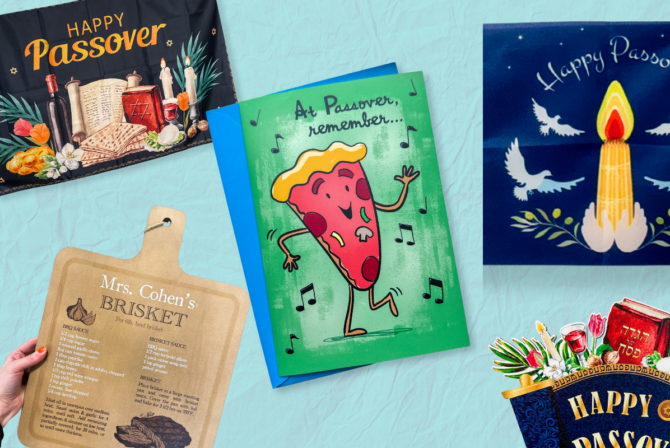I was plugging some upcoming work travel into my Outlook calendar two weeks ago when it suddenly dawned on me: Passover was seriously soon.
Like any other busy working couple, I didn’t call my husband. Instead, I shot him a message reminding him that Friday, March 30 was the first night of Passover, and that we’d have to hit the butcher so I could make my great-grandmother’s brisket — a tradition my entire family looks forward to.
A few minutes, later I got a response: “OK … but the 30th is Good Friday … I can’t eat meat.”
Ugh. I had completely forgotten — even though my family had been eating pizza for dinner on Fridays for the past couple weeks, because Catholics (like my husband) don’t eat meat on Fridays during lent.
This wasn’t the first time our religious holidays collided. In 2016, for example, Hanukkah began on December 24 — we raced home from Christmas Eve mass just in time for sundown and the Jewish portion of our festivities. We lit our hannukiah, opened presents, spun some dreidel, and then headed to our friends’ house for our annual Christmas Eve dinner.
Since there were seven more nights of Hanukkah left — plenty of time to fry up some latkes — I didn’t mind giving up some of that evening to join our friends.
But Passover is different. I love my family’s Passover traditions and foods, and I also wanted to make sure my husband could fully participate — which means, of course, eating and enjoying the brisket.
So instead, on what’s typically the night of the first seder, we’re doing “Passover Light,” as I’m calling it. We’ll eat matzo ball soup and read the from the hagaddah — we’ll do the highlights of the seder, including dipping our fingers in wine (or grape juice) as we recite the Ten Plagues, and my youngest will ask the Four Questions. But instead of our traditional meal, we’ll whip up some Lent-and-Passover-approved matzah pizza.
It may not be the way I normally do Passover, but it’s how we’re going to do it this year. And I’m OK with that.
To that end, here are some tips I have picked up over the years to make being in an interfaith relationship work, especially at “peak” times when holidays collide.
1. Lay out your non-negotiables up front. Whatever it is, be honest with your partner on what you aren’t comfortable bending on when your worlds collide. For example, I will always attend services during the High Holidays, no matter what else is going on in our secular lives — and my husband knows that. Fortunately, those don’t conflict with the Catholic holidays he celebrates, but if I was married to someone of a different faith, that could possibly be an issue. If your observances clash with your partner’s, though you may wish to share your holidays, you may need to go your own ways at times.
2. Be flexible. Yes, for as long as I can remember, we’ve had brisket on the first night of Passover. But this year, we’ll have it on the second night instead. To me, it’s the family and the food that’s more important here, rather than the date and time.
3. Synergize. Unlike a compromise — in which both parties lose some of what they want to come to a solution — synergizing is coming up with something different that works for everyone. So in this case, we could have compromised and made a vegetarian seder (as many families already do) but instead we are synergizing and creating “Passover Light” — something new.
4. Adjust expectations. All the traditions you had with your own family growing up may not pan out when you have a family of your own. So when major holidays overlap, it may mean missing a celebration or a tradition, or — better yet — coming up with a third option that benefits everyone. (See #3). Just do your best and realize no matter how hard you try, you probably can’t make everyone happy — if you can’t make the extended-family Rosh Hashanah dinner one year, you can go the next. So go ahead and adjust your expectations.
5. Embrace the season. So what if Good Friday and Passover collide this year? Though the holidays are fundamentally different, both Easter and Passover celebrate renewal and rebirth, and take place at the start of spring. Focus on the beauty of each religion’s traditions instead of focusing on the differences. In our case, it will mean accompanying my husband to Easter mass the night after our seder.
Ultimately, there is no right or wrong way to be an interfaith family. But you can learn a lot about what really matters to you — as well as what really matters to your spouse — as you navigate challenging times like these.
It may take some trial and error, but you’ll figure out what works best for your family. It may not be exactly what you pictured when you were a kid — but you couldn’t picture it any other way.







